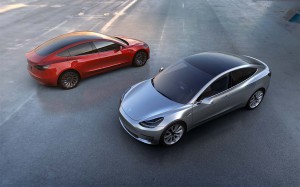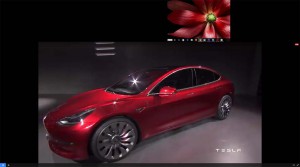
The Model 3 is slated to come to market in 2017; however, the launch comes with a hefty price tag of nearly $2 billion.
Tesla Motors CEO Elon Musk has laid out an ambitious launch plan for the upcoming Model 3 that would transform it into a mainstream automaker by 2018 – but the California battery-carmaker will need anywhere from $1.4 billion to $1.7 billion to fund the new model’s rollout and production plans, Tesla said.
It would mark the second big stock offering in barely a year for the money-losing Tesla, and word of the move sent the maker’s shares tumbling, though the stock, traded on the New York Stock Exchange as TSLA, is still well ahead of where it was prior to the March 31 unveiling of the Model 3.
In a public filing, Tesla said it needs cash to complete the development of the new battery sedan, its first to target a mainstream market segment. It also noted that it “may also use a portion of the net proceeds (for) working capital and other general corporate purposes.”
Tesla has been burning through cash at a quick pace, first to bring the big Model X SUV to market and now to finalize development of the Model 3, which will be offered at a starting price of around $35,000.
It hasn’t helped that Tesla struggled to bring production of the Model X up to target due to a variety of start-up issues, including parts shortages blamed on several suppliers. The Model X has also suffered from a variety of quality problems that have inflated factory and warranty costs.
(Why is Elon Musk sleeping on the factory floor? Click Here to find out.)
On May 4, the battery-electric automaker said it went $282 million into the red for the first three months of the year, or $2.13 a share. Excluding one-time items and using so-called non-GAAP accounting, the lose shrank to $75 million, or 57 cents a share, which was better than Wall Street had forecast, according to a survey of analysts by S&P Global Market Intelligence.
Analysts have been decidedly mixed in their forecasts for Tesla. While influential Goldman Sachs said this week it sees plenty of upside potential, others have been far less bullish. That includes Efraim Levy, of S&P Global, who is maintaining his “Sell” guidance. According to Levy, the offer of 9.6 million new shares isn’t going to raise as much capital as expected and will still result in a 10% dilution for current shareholders.
Tesla held its first public offering in June 2010 and has since raised $4.5 billion from investors.
One key reason for the ongoing debate over the company’s share price is uncertainty about the aggressive rollout plans announced by CEO Musk in March. He expects to have the new Model 3 in production by the second half of 2017, producing at least 100,000 before the end of the year. The goal is to get up to 500,000 in 2018.
(Tesla still in red, but losses narrow during Q1. Click Here for the latest.)
Initial public response has been overwhelmingly positive, the automaker said, noting it has received over 300,000 advance reservations – which each came with deposits of at least $1,000.
“We have obtained this level of reservations without any advertising or paid endorsements, with only a few social media posts leading up to the unveiling, without anybody but those who were in attendance on March 31 having had an opportunity to test drive the car, without yet publicly disclosing numerous features about the car,” said the maker, adding it believes it could generate even more reservations “with minimal effort.”
Whether those reservations will translate into actual sales remains to be seen, in part because a number of other automakers are readying lower-cost, longer-range battery-cars, notably including the Chevrolet Bolt set to launch later this year.
(Tesla claims it has developed a bio-defense mode for its battery-cars. Click Here for the story.)
More concerning to skeptics, Tesla has a history of launching late and ramping up production slower than promised. It was two years behind schedule with the Model X, for example, and only recently got up to speed at the company’s Fremont, California assembly plant. It remains uncertain how delays with the Model 3 would impact sales, but some observers fear it could lead some buyers to cancel their reservations.

